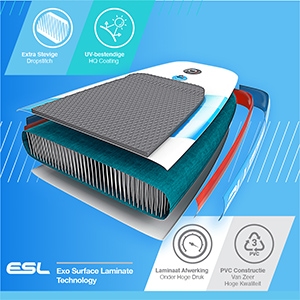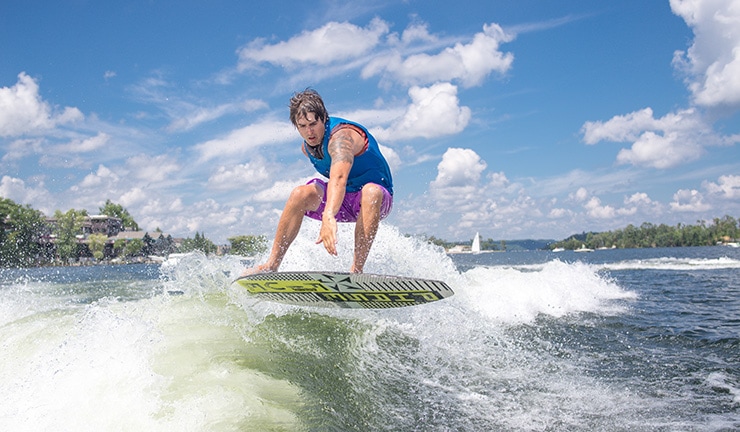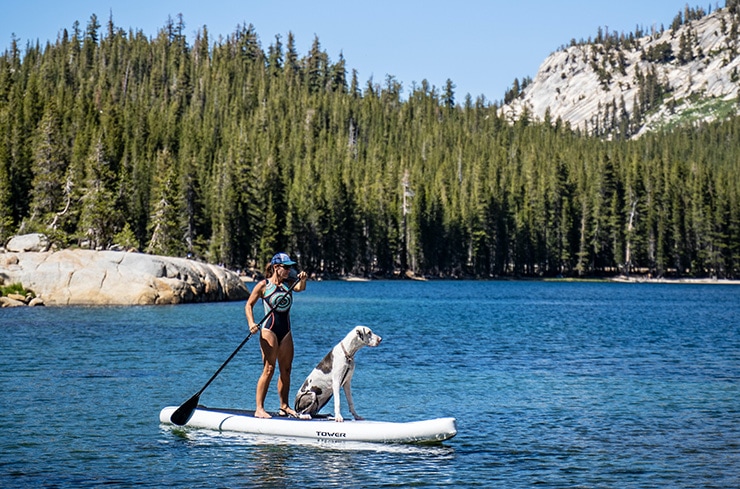If you struggle to distinguish between surfboards and paddle boards, you’re not alone. The two can be confusing. Sure, each watersport seems different and a paddle board appears to be bigger than a surfboard. But is that all?
The answer is no. There are plenty of differences between surfing and paddle boarding, and therefore the difference between a surfboard and a SUP board is more than just “one is bigger than the other.”
Understanding the differences is important, especially if you’re trying to choose between the two.
Let’s take a deep dive into the surfboard vs paddle board discussion.
What Are the Differences Between a Surfboard and a Stand Up Paddle Board?
A surfboard and a SUP board may look the same from a distance–save for the size. But here is how you can tell them apart.
Construction Style and Materials
Starting with paddle boards, they can either be solid or inflatable.
Solid paddle boards are made of fiberglass, wood, wood veneer, or plastic. Their construction begins with a foam core, usually EPS. From there you have layers of fiberglass or wood veneer, which is finally coated with epoxy resin.
Some wood paddle boards can be hollow, that is, they don’t have a foam core. The same goes for plastic SUP boards.
You may have also heard of soft-top stand up paddle boards. These fall into the solid category. They are made of foam which is wrapped in heat laminated polyethylene.
Soft-top and plastic SUP boards aren’t expensive. The plastic ones can be quite heavy though.
Wood and fiberglass boards cost more but they perform much better. They make great performance SUPs.

Moving on to inflatable paddle boards, they don’t have a foam core. Instead, their construction begins with dropstitch construction. Two layers of fabric are joined together by thousands of tiny threads. This design ensures that your SUP maintains its shape when inflated.
On top of the dropstitch fabric is a layer or more of PVC–which is an airtight material. Inflatable boards with a single PVC layer are lighter but not very durable. Multiple layers of high-quality PVC make an inflatable paddle board much tougher.
Surfboards only come as solid boards, with no inflatable versions, for now.
Their construction is quite similar to that of solid SUP boards, with a few differences. There are soft top, wood, polyurethane, and fiberglass surf boards.
Like stand up paddle boards, surfboard construction begins with a foam core to give the boards buoyancy. Manufacturers mainly use three foam types for surfboards: polyurethane (PU), expanded polystyrene (EPS), and extruded polystyrene (XPS).
Surfboards have a stringer which makes the board stronger and more rigid. The stringer is normally made of PVC or wood.
From there, another layer of material is added to make the surfboard even stronger and ideal for surfing. This material could be fiberglass, bamboo, or carbon fiber. Carbon fiber boards are extremely strong and rigid, but equally expensive.
Bamboo is lighter and harder to ding, making it fantastic for surfing. It is environmentally friendly too, which is a huge plus.
Surf boards, like paddle boards, also have resin finishing–usually, epoxy or polyester resin.
There are soft top surfboards too. They are inexpensive and stable, ideal for beginner surfers.
Board Size
The easiest way to tell a surfboard from a paddle board is by size.
Generally, paddle boards are bigger than surfboards. This has everything to do with what each board is designed to do.
Stand up boards are meant to glide over the water and keep the rider afloat. They, therefore, have to be more buoyant and stable. Surfboards, on the other hand, are designed for riding waves and they have to be more agile and maneuverable.
For a stand up paddleboard to be more buoyant it needs to have more volume. And volume is determined by the length, width, and thickness of the SUP. This is why SUPs are generally longer, wider, and thicker than surfboards. The bigger size also gives them more stability.
ALSO READ: What Size Paddle Board Do You Need for Your Weight?
Inflatable paddle boards are five to six inches thick while solid SUP boards are about four inches thick.
It’s important to note that paddle boards vary greatly in size, depending on what their purpose is. For instance, racing SUPs are narrower, about 28 inches wide, and longer, 12 (or more) feet long. Surfing paddle boards are narrower and shorter. Recreational boards are somewhere in the middle.
But the average length of a SUP is 11 feet and the average width is 33 inches.
Surfboards are much shorter, eight feet or shorter, and narrow, usually 22 inches or narrower. They are also thinner, about three inches, and have less foam volume.
Surfing longboards are usually longer, like paddle boards, but they’re still much narrower and thinner.

Size of the Rocker and Shape of the Board
Rocker is the curvature or shape of a board when you look at it from the side, nose to tail. Boards that are more curved–like a banana–are said to have more rocker. Boards that are less curved and flatter are said to have less rocker.
More rocker makes a board much easier to turn and more maneuverable in general, great if you want to ride waves.
Surfboards that are more curved have fantastic agility and are super responsive. They’re great for advanced riders who want to surf steep and powerful waves, without the nose of the board diving into the wave.
So the more the rocker, the more responsive the board, and the easier it will be to surf bigger waves.
Beginner surfboards have less rocker and are ideal for riding smaller waves.
While the banana shape makes a board more maneuverable, it slows it down. This is not ideal for flat water stand up paddling. You’ll struggle to make the board travel straight if it’s more curved and it will be slow too.
Paddle boards have less rocker–just enough to keep the nose from digging into the water. This ensures that they don’t lose their ability to track well and cruise fast on the water.
SUP boards designed for SUP surfing will, however, have more rocker to make them better suited for riding waves.
The Different Types of Hulls
There are two main types of hulls that you find in paddle boards and surfboards: the planing hull and the displacement hull.
The planing hull is flat-bottomed and, as the name suggests, it planes or skims over the water surface. Boards with a planing hull are maneuverable and easy to turn.
The displacement hull, on the hand, is V-shaped and cuts across the water, displacing it. Boards with a displacement hull glide fast and track well, that is, they travel in a straight line easily.
Surfboards have the planing hull type because maneuverability is key when surfing.
Racing and touring paddle boards have a displacement hull and are not particularly stable because they’re also narrow and long. These boards are designed for experienced SUP boarders who want to paddle fast. Speed is more important than stability with racing SUPs.
Other boards–for SUP yoga, recreational paddling, surfing, and whitewater–have planing hulls.

Function and Versatility
Surfboards are designed for catching waves, and not much else. A traditional surfboard has one function so there isn’t really any versatility.
Stand up paddle boards can do so much more than just regular, casual SUP boarding; SUP is actually a very versatile sport.
Other than paddling leisurely on your SUP board, there are other SUP activities that you can do. You can try SUP yoga, touring, fishing, racing, whitewater, and even SUP surfing!
If you want to try a little bit of everything, you can get an all-around paddle board. You can do most of the SUP activities with it as you learn what you like. All-around boards are perfect for beginners too.
If you decide to focus on one SUP activity, there are specialized boards for each activity. You can find yourself a long, narrow fiberglass board with outstanding speed for racing and touring. Or maybe a wide inflatable paddle board for yoga.

Use of a Paddle
Another major difference between paddleboards and surfboards is the use of a paddle.
A surfer on a typical surfboard doesn’t need a paddle to catch waves. They typically lay on their surfboards and paddle out with their hands.
Paddle boarding requires a paddle because the rider stands on the SUP and has to paddle using a paddle. In fact, most boards come with a paddle in the package. You can’t stand up paddle board without one.
Price
Generally, surfboards are cheaper than paddle boards. But you should know that the prices of both board types vary greatly.
There are good quality surfboards that cost $250 but you can also find others that cost as much as $1000.
For a nice, well-made all-around SUP, you should be ready to cough up at least $500. There are cheaper options though. High-end specialized paddle boards can cost as much as $2500, sometimes more.
Can I Use a Surfboard As a Paddle Board?
No, you cannot use a normal surfboard as a paddle board.
Surfboards are small and thin, which results in them being less buoyant and unstable. You can stay on board without falling when prone paddling on a surfboard or riding a wave. But if you try to stand on flat water, you’ll find the board tippy and you will fall off.
Surfboards also can’t track as well as paddle boards. A regular surfboard is short and narrow with more rocker. These features make it agile and responsive but the board won’t track well on calm water.
Can I Use a Paddle Board as a Surfboard?
Yes, you can use your paddle board as a surfboard.
Stand up paddle boards are versatile and you can use them for catching waves. The size of waves you can ride depends on the SUP you have. A smaller, more maneuverable paddle board would work better.
How About a Hybrid Surf Paddle Board?
If you want to get into serious paddle board surfing, there are SUPs designed specifically for riding waves.
They are shorter, narrower, and thinner than the average paddle board. Most of them are solid SUPs too because they perform better than inflatable SUPs in this case.
Is Paddle Boarding Easier Than Surfing?
Yes. In my opinion, paddle boarding is easier than surfing.
You can easily learn to balance on a SUP on calm water–and you don’t even have to stand at first. You can start while seated or kneeling.
Surfing is a little more advanced and there is more you need to learn.

Does Paddle Boarding Help with Surfing?
Yes, many experts will tell you that SUP helps you with surfing.
First, stand up paddle boarding engages the key muscles used for surfing, more the core and leg muscles. It also greatly improves your balance. As you get better at paddling, you can try catching smaller waves with your SUP.
This way, transitioning to surfing won’t be challenging. You’ll have an easier time learning compared to a non-SUPer.
Conclusion
Surfboards and paddle boards are similar in many ways but they’re not the same.
SUP boards are bigger, more buoyant, and more stable. Stand up paddling is also more versatile as there’s so much you can do with a paddle board. There’s SUP fishing, yoga, touring, racing, and more.
Paddle boards come as inflatable or solid and you need a paddle to SUP.
Surfboards are smaller with less volume, making them more responsive and perfect for catching waves –and you don’t need a paddle for surfing.
Inflatable surfboards are not a thing yet, but that may change soon.
As far as versatility goes, surf boards are built for one thing only. If you want to take up a water sport that will allow you to do multiple different types of activity, a SUP board is the way to go.

